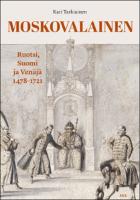Moskovalainen
Ruotsi, Suomi ja Venäjä 1478–1721
Abstract
The great change in European relations with Russia took place in 1478 when Muscovy replaced the trading Republic of Novgorod as a neighbor of Sweden, Livonia and Lithuania. Western Europe was since that year bordering to a bellicose great power with large resources causing dread. The feelings of dread caused by Russia with Czars like Ivan the Terrible became a standing theme in printed matter as well as politics and the image of Russia became very much similar to the image of Turkey, which threatened Europe from South-East. Various, usually rather negative, stereotype expressions characterized the vocabulary of the 16th century.
The Peace of Stolbova in 1617 started a period of successive change. The era of Sweden as a Great Power led to growing knowledge about Russia in almost every respect, but it was still based on the already accepted stereotypes. They started, however, typically to seem more diluted and thin with time. The image of Russia as a threat was to a growing extent replaced by an image of a possibility. The perhaps most remarkable but rather unoriginal printed Swedish description of Russia of the era was Regni Muschovotici Sciographia, published by Petrus Petrejus.
At the final stage of Sweden’s era as a great power there was a substantial widening but also polarization of the information on Russia. The Russian reform process during Tsar Peter I also began to influence the minds after the turn of the century in 1700. One of the principal describers of this process was Lars Johan Malm (Ehrenmalm), whose large manuscript about the power of the Russian Empire of that time, Några Anmärkningar Angående det Ryska Rijkets Nuvarande Macht from 1714, never reached the printers due to intervention from censors.
Keywords
Russia; international relations; image of Russia; political history; Finland; SwedenDOI
10.21435/ht.286ISBN
9789518585742, 9789518585759, 9789518585766Publisher
Finnish Literature Society / SKSPublication date and place
Helsinki, 2022Imprint
Finnish Literary SocietySeries
Historiallisia Tutkimuksia, 5Classification
History


 Download
Download Web Shop
Web Shop